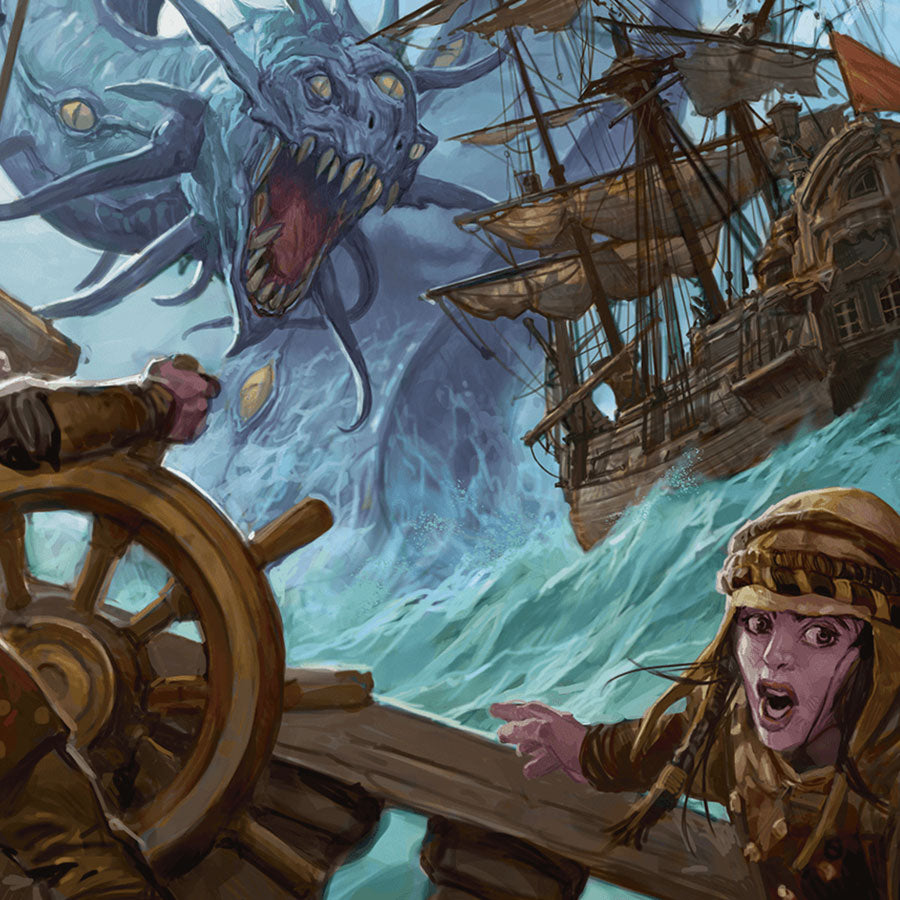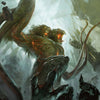How to Convert D&D 5e Adventure Modules to a Different Game System

Written by Luke Hart
Perhaps you’ve decided to leave behind D&D fifth edition and move to Pathfinder 2nd edition or another game system, but you still want to run some cool 5e modules such as Rime of the Frostmaiden or Curse of Strahd. Or perhaps you have modules and adventures in older editions of D&D or other RPGs like Pathfinder 2, and you want to run them in fifth edition… or a system like Savage Worlds. The challenge before you then is to convert that old module or adventure to a new edition or an entirely different game system. So, today, we’re going to discuss the basic principles for how to do just that.
Watch or listen to this article by clicking the video below.
#1 Know Your Starting Point and Your Goal
First, you need to understand the design of the adventure in the context of the original edition or system. Some older modules are designed to have a LOT of easier encounters and only rarely have a hard or deadly encounter. According to WOTC this is true for first and second editions. Other modules use encounter difficulty rules found in their relevant edition; that is, they are designed to be hard, or easy, or deadly, and the difficulty may vary. Also, you want to know what the difficulty of the adventure as a whole is. Often, the difficulty of an adventure is key to the story of the adventure; for instance, adventures whose plotline indicates that the enemies are “dangerous” usually feature encounters that are more dangerous.
Next, seek to understand the design philosophy of the adventure. For instance, those modules with lots of easier encounters are NOT that way the game was poorly balanced or too easy. Instead, the philosophy of the adventure was to make the encounters easy so the characters could fight more and explore more during the adventure. The second part of this philosophy is that large numbers of easy encounters are easier to combine into larger encounters depending on player choices. For example, if the character make lots of noise and alert several rooms of baddies to their presence, several easy encounters can be combined into one more challenging encounter on the fly. Other modules use a philosophy of creating a variety of difficulties so nobody ever knows what’s around the next corner. I personally prefer this approach, but that’s just me. Of course, still others will use a lot of dangerous traps, puzzles, or other exploration elements that are meant to provide a different atmosphere to the adventure as a whole.
And now that you understand how and why the adventure or module was designed the way it was, you ask yourself “What do I want as the end product?” Do you want something that stays true to the original module but uses the mechanics of D&D 5e or Pathfinder or Savage Worlds? Or, do you just want to use the same plotline and overall story, but change the design using your own design philosophy? Or do you have some other goal in mind? And now that you know where you want to GO, there are really just FOUR MAIN CATEGORIES of game mechanics that need converting from one system or edition to whatever you are using: encounters, skills, difficulty classes, and treasure.
#2 Convert Encounters
What you want to change about the encounters is going to vary depending on what your end goal is. If you want to stay true to original, keep encounter difficulty the same, obviously. If you are going for a different design, then there will be more complex changes.
If staying true to original, the goal here is to keep the encounters about the same difficulty and same frequency. You don’t need to keep the same number of monsters in each encounter. Rather, focus on the feel and difficulty of the encounter in accordance with the design philosophy of the adventure. For instance, D&D 5e single monster encounters are usually far easier than their CR would predict. Whereas, a small horde of low CR creatures could turn out to be rather challenging, even for a higher-level group.
So, if the original edition has just a couple monsters in an encounter, but it’s a TOUGH encounter, you could convert it to D&D 5e and use six monsters instead, because larger groups are more challenging in 5e. However, if you’re going from say D&D 5e to Pathfinder 2e, things are different. In Pathfinder 2e, solo monsters that are a two or more levels above a party’s level are going to be VERY CHALLENGING. So, if you’re going from D&D 5e to Pathfinder 2e and the original has three monsters, you might replace it with just ONE and still achieve the same encounter difficulty. It all really just depends on the editions and systems you’re converting from and to.
Now, if your goal is to change the design of the encounters, either making them easier or more challenging, or having fewer or more encounters -- without changing the adventure -- things get slightly more complicated. Not only will you be adjusting encounter design, but you’ll also need to keep an eye on the design of the adventure, insofar as challenge is concerned. That is, you may be making the adventure as a whole more or less challenging, and you’ll need to monitor that. In a system such as D&D 5e, this is done using the adventuring day mechanic, but some systems, such as Pathfinder 2e may not have an out-of-the-box mechanic for this, and you’ll have to rely on your experience and intuition instead.
So then, whether you are seeking to duplicate the original or redesign it according to your own desired difficulty, you’ll get to work converting the encounters from one edition or system to the other. This is, of course, going to rely on your own understanding and experience with the two editions or systems, and I’m sure you’ll be doing some number crunching as you’ll need to use whatever challenge rating mechanics the editions or systems use. Fortunately, though, online calculators are very prevalent and take a lot of that burden off your shoulders.
Basically, when doing the conversion, you’ll need to pick similar monsters or use the same monsters and adjust how many of them there are so that you get the encounter difficulty you’re aiming for in the new edition or system. Of course, you may need to create some custom monsters, too, that will fit the challenge you are going for, though this is probably mostly optional. I don’t think there is an easy formula for encounter conversions from one edition or system to another – at least not one that considers all editions and all systems. However, once you get down to it, I’m sure you’ll discover that it isn’t as complicated as it may seem.
#3 Convert Skills
Most editions of D&D or RPG systems such as Pathfinder use some sort of skill system, and many things a character might want to do lie in the domain of one (or potentially more) skills. That goal when converting from one edition or system to another is to, of course, convert those skills as well. Not all skills that may have been used in older editions are included verbatim in new editions, such as D&D 5e. Many have been merged or dropped entirely. Use Magic Device from D&D 3.5, for example, has mostly been dropped from D&D, though some of its checks may fit under the Arcana skill. Likewise, if you’re dropping D&D 5e and moving to Pathfinder 2nd edition like I am, then you’ll find that though Arcana does still exist there’s also Occultism, which might work for certain checks, too.
To determine what the proper skill conversion would be, you essentially need to use your knowledge of the two editions or systems and your best judgment. And the fact of the matter is that as long as you are CLOSE, things will be just fine. It’s not that big of a deal. If you call for an Occultism check instead of an Arcana check, your players probably aren’t going to mutiny.
#4 Convert Difficulty Classes
However, remember, you’re not just converting the TYPE of skill, but you also need to convert the number associated with a skill check. For instance, if in D&D 5e it’s a DC 15 Arcana check, does that cleaning translate to a DC 15 Occultism check? Well, probably not, because numbers scale differently in Pathfinder 2e. It might actually translate better to a DC 20 or 25 Occultism check, depending on the circumstances such as the level of the party.
So, here what you need to consider is the general Difficulty Class in the base edition or system of the skill you’re converting and seek to replicate it (or change it, if desired) in the system that you’re converting it to. For instance, in D&D 5e, a DC 15 is generally considered MODERATE difficulty, even for mid-level groups because of the bounded accuracy system it relies on. However, in Pathfinder 2e, a DC 15 check could be laughably easy for a mid-level group. So, I might want to bump that up to a 20 or 25 and require that the character be an Expert in the skill to even make an attempt.
#5 Convert Treasure
Different systems and editions have different methodologies for rewarding loot in the game. For instance, you take a system like D&D 5e and according to the game designers and the core rulebooks, the lack of magic items doesn’t influence the game much, whereas experientially we all know that too many magic items throws balance all to whack. And when we look at gold and other forms of money, it really only has value in the early levels when the group is dirt poor, but by mid-levels, groups are swimming in money with nothing to spend it on – at least if we only use the core rulebooks.
However, a system like Pathfinder 2e seems to be much better balanced, gives specific recommendations for number and power of magic items to be given at certain levels, and is designed around a better economy out-of-the-box for earning and spending money. So, when you are converting from one edition or system to another, you’re not always going to just have a one-to-one conversion. Doing that could screw things up royally.
What you need to do instead is consider the context of the loot in the original – is it sparse or generous or somewhere in between – and then either try to replicate that in your conversion, or change it to suit your fancy. If I were converting from D&D 5e to Pathfinder 2e, for instance, I would probably scrap the loot entirely from the original adventure or module, and create new loot based on the recommendations in the Pathfinder 2e Core Rulebook. With one caveat: if there was loot in the original that was THEMED according to the adventure, I would seek to find a suitable replacement or homebrew something of my own.
100 Years of GM Experience at Your Fingertips!
Are you a NEW GAME MASTER feeling a bit overwhelmed by everything involved with running a role-playing game? Are you a VETERAN GAME MASTER looking for new tips and tricks to take your games to the next level? Look no further than the Secret Art of Game Mastery.
We at the DM Lair have distilled our CENTURY of accumulated GM experience into an easy-to-read guide of practical advice that you can immediately apply to your games! We've even included our own templates–the things that we use to prepare our ACTUAL games.
Get all three books to master your game:
- The Secret Art of Game Mastery. Contains over 100 years of GM advice distilled into an easy-to-read format. It introduces and explains the tools of the trade, scheduling, playstyle, post-game notes, getting player feedback, and more.
- The Secret Art of Preparation. Brings to your fingertips the actual templates and guides that the DM Lair team uses to prepare games, Lair Magazine, and more. Designed as a three-ring binder, it's intended for you to write directly into for your entire campaign!
- The Secret Art of Notetaking. Gives you the keys to tracking your campaign from session to session just like the DM Lair team. Designed as a three-ring binder, it's intended for you to write in and keep track of your whole campaign!
With so much knowledge and experience on its pages, The Secret Art of Game Mastery is guaranteed to become an indispensable tool for all game masters, new and veteran alike. And if that isn’t enough, the information applies to all game systems and all genres!
-
Posted in
Game Master How-To Articles







